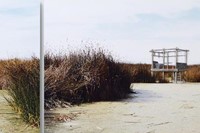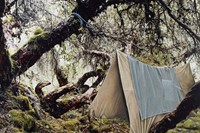Entering the Victoria Miro gallery to see Alex Hartley’s latest sculpture exhibition, the first thing that strikes the eye is the absence of sculpture in any perceivable form. Large canvases hang from the walls; landscape photographs featuring
Entering the Victoria Miro gallery to see Alex Hartley’s latest sculpture exhibition, the first thing that strikes the eye is the absence of sculpture in any perceivable form. Large canvases hang from the walls; landscape photographs featuring lonely structures in inhospitable surroundings. Yet moving closer reveals that the sculptures and the structures are one and the same, buildings built onto and carved into the landscape itself.
Hartley is an artist who is fascinated by the remote and the isolated. His work is a meditation on the interrelation of man, structure and nature, and the impact this has on the world. He forces a change of perspective, creating narratives of “lighthouse” figures, alone and unseen, challenging the hostility of the wild. To compliment this, and part inspired by the Drop City hippie community created in 1960’s Colorado, he has built a real life structure from car bonnets and scrap metal out the back of the gallery, where he is living throughout the course of the exhibition – taking on the role of the “man” who inhabits each of his images. Here he talks to AnOther about reimagining the narrative of isolated landscapes and his deeply primal desire to live there…
How do these images originate in your mind?
They are all taken in various different wilderness, edge spaces. I take the photos, then I get them printed up and they sit around in the studio for several months, until I work out what it is I think should go into them, what the occupation thing is. There is a sort of runback from the frozen moment of the photograph into the creation of a back-story – who the man is who lives there - and essentially it’s always becomes a version of me who ends up living in them, because they take so long to formulate that by thinking I inevitably take possession of them myself.
Where do the landscapes come from, and how do the works form?
The art is really an investigation of my desire to live in these spaces, where I go travelling, climbing, exploring. I don’t consider myself a photographer, I consider myself a sculptor, so I use photography to create a frame for an object I can build.
The structures are largely creations of my mind, like in All Hope is Gone, the photograph for which I took on Lake Titicaca. People there were religiously persecuted and so fled out into the lake and created reed islands on the water. The structures I built in represent lookout posts for those communities. What is a common thread through the work is that my man, me, has come in and occupied space that had been set up for some ideal or some religious purpose before. I think that’s the narrative I make to join them.
"The art is really an investigation of my desire to live in these spaces, where I go travelling, climbing, exploring. I don’t consider myself a photographer, I consider myself a sculptor, so I use photography to create a frame for an object I can build."
This is a project that’s taken so many years – was it something you imagined happening from the start or has it come about incidentally as your collections of photographs grew?
I lived in California for a bit, and I started jumping over people’s fences and photographing their houses and settings, because you’d go through the architectural guides and want to see all these things, but then they would be hidden behind fortified fences, so I just started hopping over and photographing them. I quite like that invasion of privacy element as well. Around the same time I started taking these landscape photographs, and then I wanted to build my own stuff – I’ve always been something of a frustrated architect. So this combines the two – that idea of guerrilla art creation, breaking in, inhabiting inhospitable wildernesses along with building your own home.
Do you think the isolation idea comes from a personal, primal desire of your own to live like this, an impossible dream that you are assuaging with this series?
I am completely open about that – I’m happiest when I’m in these places – but I also know the reality of how it would be to really live like that. Finding purpose and gaining purchase in that space; it would eventually catch up with you. And also of course I have a family and that desire to be on your own in wilderness, which is really primal in me somehow, has always fought with reality and my family life, and being productive as an artist. And this plays out in the work's creation. Often they begin with me trying to build these amazing, sparkling finished objects, but it’s inevitable that the back-story takes over and decay and dystopia creeps within. So, in a way, I live my fantasy in this, a fantasy that vitally comes to a close. There is something cathartic about it, when I can finally let go of these funny stories I’ve been living in for months.
Alex Hartley: The World is Still Big is at the Victoria Miro Gallery until 21st January 2012, and also features artifacts and information for Alex Hartley's 2012 Cultural Olympiad Project NOWHEREISLAND. To join the project's international community , click here.



